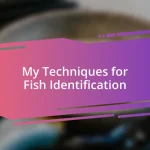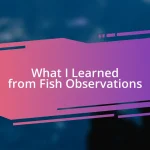Key takeaways:
- Trout are most active during dawn and dusk, and they prefer specific habitats like shaded areas and undercut banks for safety and food.
- Choosing lightweight and sensitive gear, such as a medium-light rod and low visibility line, enhances the trout fishing experience by improving bite detection and reaction time.
- Weather conditions, including temperature, moon phases, and precipitation, significantly affect trout behavior and can lead to more successful fishing trips when properly analyzed and utilized.

Understanding trout behavior
Trout are fascinating creatures, and their behavior can change based on various factors, like temperature and time of day. I remember one early morning, watching a group of trout near the surface, darting around. It dawned on me that the cool morning temperatures invigorated them, making me wonder—how often do we overlook the simple connection between fish and their environment?
Understanding when trout are most active, usually during dawn and dusk, can be a game changer. There was this one time I went fishing at twilight, and the bites were relentless. It felt magical, almost like I had cracking the code of their routine, reminding me that patience and timing are vital in this sport.
Additionally, trout often seek out specific habitats, such as pools, undercut banks, and riffles. I learned this while exploring a local stream, noticing how they gathered around shaded areas during the heat of the day. Have you ever observed how they prefer certain spots? It’s intriguing how these behaviors reveal a lot about their instincts for safety and food.

Choosing the right gear
When it comes to choosing the right gear for trout fishing, having the right tools truly enhances the experience. I remember switching from my trusty old rod to a lighter setup one day—it was a revelation. The sensitivity of the new rod made every nibble feel amplified, allowing me to hook more fish simply because I could react quicker.
Here are some essential gear components to consider:
- Rod: A lightweight and sensitive rod can improve your ability to detect bites. I’ve personally found that a 6-7 foot medium-light rod works wonders for finesse fishing.
- Reel: A smooth reel is crucial. Opt for a spinning reel with a reliable drag system, something I learned the hard way during a battle with a feisty trout that nearly stripped my line.
- Line: Use a low visibility line, like fluorocarbon. It made a noticeable difference after I switched during a particularly challenging fishing trip.
- Hooks: Match the size of your hooks to the bait you’re using; smaller hooks often entice more bites, based on my experiences.
- Tackle Box: Keeping your tackle organized saves time on the water. I remember fumbling through my box in search of a specific lure and missed out on a great catch because of it.
Having the right gear tailored to trout fishing can be a game changer. On days when I’ve followed these tips, I’ve felt more connected to the water, almost like it responds back to my choices.

Selecting effective bait types
When selecting effective bait types for trout, I’ve learned that matching the bait to the trout’s diet is incredibly important. I like to think of it as preparing a meal based on what I’m craving at a restaurant—it just makes sense! One time, while using scented dough balls, my catches skyrocketed compared to when I only relied on plain spinners. It reminded me that sometimes flavor is the key to attracting the right crowd.
The environment also influences what bait works best. In streams with plenty of minnows, using small minnow imitations often leads to better success. I remember a particular outing where fellow anglers around me struggled while I pulled in fish after fish with a simple baitfish replica. The contrast in our experiences made me realize the importance of adapting to the surroundings and the natural food sources available.
Here’s a quick comparison to help you decide on your bait options:
| Bait Type | Best Use |
|---|---|
| Worms | Overall, especially in ponds |
| Scented dough balls | Best for lakes, great for ambush hunters |
| Minno imitations | Effective in streams with abundant minnows |
| Spinners | For active fish in clear waters |
| PowerBait | Ideal for stocked fisheries |

Identifying prime fishing locations
When I’m scouting for prime trout fishing locations, I start by looking for areas where water flows create perfect hiding spots. For instance, I often head to the bends of streams, where the current slows down. I’ve experienced days where simply anchoring my spot near an overhanging tree resulted in a steady stream of bites; it’s as though the fish had taken refuge there, waiting for a snack to float by.
Water temperature plays a crucial role in trout behavior, and I remember a particularly successful fishing expedition on a crisp spring morning. I had checked the water temperature, and it was a refreshing 55 degrees—optimal for trout! During that outing, I could almost predict where the fish would be, just by observing the water’s warmth and the surrounding foliage. Have you ever noticed how fish cluster near aquatic vegetation? Those lush patches often signal abundant food, which is irresistible for hungry trout.
Another factor I pay attention to is the structure beneath the surface. Rocky areas and submerged logs create ideal ambush points for trout. On a memorable trip, I tied my bait to a small jig and cast it near a cluster of rocks. The thrill of feeling that unmistakable tug on my line reminded me just how rewarding it can be to fish near these natural structures. It’s like discovering the hidden gems of a lake! Do you have your favorite spots where you consistently see success? Finding that perfect location makes all the difference in your fishing experience.

Mastering various fishing techniques
When it comes to mastering various fishing techniques, I’ve found that versatility is key. Over the years, I’ve experimented with everything from fly fishing to spinning. One particularly memorable day, I decided to switch from my regular spinning setup to a fly rod, and let me tell you, it felt like I was rediscovering the art of fishing all over again. There’s something poetic about casting a fly and watching a trout rise to meet it; it adds a layer of excitement that transforms the whole experience.
Drifting and jigging, for instance, can be game changers. I vividly recall a chilly afternoon on a river, where the drift technique changed everything for me. By allowing my bait to float naturally downstream, I started hooking trout consistently while others around me got skunked. It was as if a light bulb went off in my mind—adapting my technique to the water’s flow made all the difference. Do you prefer a more active approach with jigging or a stealthy drift? It’s intriguing how personal preference in technique can shape not just our success but also our enjoyment.
Then, there’s the thrill of learning to read the water, which has enhanced my fishing game tremendously. I remember standing on the bank of a lake, scanning the water, and spotting subtle ripples indicating feeding fish. Adapting my cast to target that area resulted in an immediate bite. Reflecting on those moments reminds me that each outing is a lesson in observation and adaptation. Have you taken the time to really study the water conditions? The nuances you notice can dramatically elevate your fishing success.

Timing your fishing trips
In my experience, fishing timing can make or break an outing. I’ve found that early morning and late afternoon, just before dusk, are often the golden hours. One early morning, I arrived at my favorite lake just as the sun began to rise, illuminating the water in hues of gold. It was a magical moment, and as I cast my line, I felt an immediate connection; the trout were rising to the surface, actively feeding, and I couldn’t reel them in fast enough. Have you ever felt that rush when everything aligns?
Another crucial aspect is the moon phase. I still remember a particularly fruitful trip during a full moon. The later it got, the more active the fish became, almost as if the bright moonlight ignited their natural instincts. I adjusted my fishing time accordingly, and those late-night casts felt exhilarating, often resulting in larger catches. Have you experimented with fishing under different moon phases? It’s fascinating how these natural cycles can influence fish behavior.
Weather conditions also play a pivotal role in timing your fishing trips. I recall an overcast day when I decided to head to the river despite the gloomy forecast. Many people shy away from fishing when it’s cloudy, but I’ve discovered that trout often become more active during such conditions, especially right before a rainfall. As I watched the raindrops ripple the surface, I knew I was in for a treat. How often do you take advantage of less-than-perfect weather? Those days can sometimes surprise you with the best catches!

Analyzing weather conditions for success
Understanding weather conditions is a game-changer when it comes to consistently catching trout. For instance, I once fished on a blustery day where other anglers stayed at home. The wind was howling, but I found that the trout were on fire that day, likely driven to the shallows by the crisper temperatures and incoming storm front. Have you ever noticed how fish seem to detect changes in barometric pressure long before we do? It’s intriguing how fine-tuning our trips based on weather can lead to incredible outcomes.
I’ve also learned that temperature impacts trout behavior profoundly. One summer, I found myself fishing a small creek during an unexpected cold snap. The water was surprisingly chilly, yet my luck changed the moment I used a smaller bait mimicking the local minnows, which were lethargic in those conditions. I can still feel that adrenaline rush when I hooked a heavy trout, demonstrating that adapting to temperature shifts can lead to rewards. What adaptations have you made to adjust for temperature changes?
Precipitation is another critical weather factor to consider. I vividly recall a day when light rain set in just as I arrived at my favorite spot. Instead of packing up, I decided to take a chance. As the rain hit the water, the trout became more active, darting around in a feeding frenzy. It was exhilarating to feel the pulls on my line as I pulled in catch after catch. Have you ever considered how rain might actually work in your favor rather than against it? It’s a reminder that embracing the unpredictable can lead to rewarding experiences in fishing.















